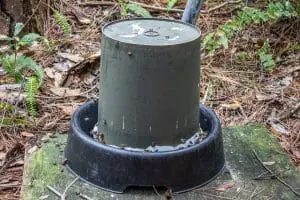

We’ve noticed an uptick of bees in the Zoo this winter, so we’re trying a few ways to deter them from the main guest pathways.
Got bees? We do!
If you’ve visited our Zoo over the last few weeks, you may have noticed quite the buzz of bees, especially around our trash cans. This happens primarily in winter months since less flowers are blooming to provide food. Bees will rely on their honey stores to feed the colony throughout the winter but if they don’t have enough and the weather is warm, they’ll start to look for alternative sources of food.
These sources happened to be the Zoo’s trashcans filled with delicious, discarded treats like soda, slushies, ice cream and other sugary items.

These devices have been placed in different areas in our Zoo to coax honeybees off most of our main pathways.
We are encouraging these bees to avoid our main pathways by offering alternative feeding locations in different areas around the Zoo. These large buckets are set up so only bees can access the sugar water inside.
Our beekeepers have inspected the Zoo’s hive and found that it’s well-stocked with honey for this season, so only a small amount of nectar is being brought in. Honeybees have a foraging range of 2 miles, so the bees you see around the trashcans are most likely coming from the outside area looking for food – and they found a plentiful supply!
People, animals and the environment are all deeply connected, and our shared future depends on protecting and restoring diverse ecosystems and their inhabitants – like bees!
Bees are essential to healthy ecosystems and important pollinators for food crops. If you’d like to help honeybee populations, you can plant pollinator friendly plants that bloom year-round and advocate for (and participate in) using less pesticides.
Brevard Zoo is an independent, not-for-profit organization that receives no recurring government funding for our operating costs. Your generous support enables us to continue to serve our community and continue our vital animal wellness, education and conservation programs.
